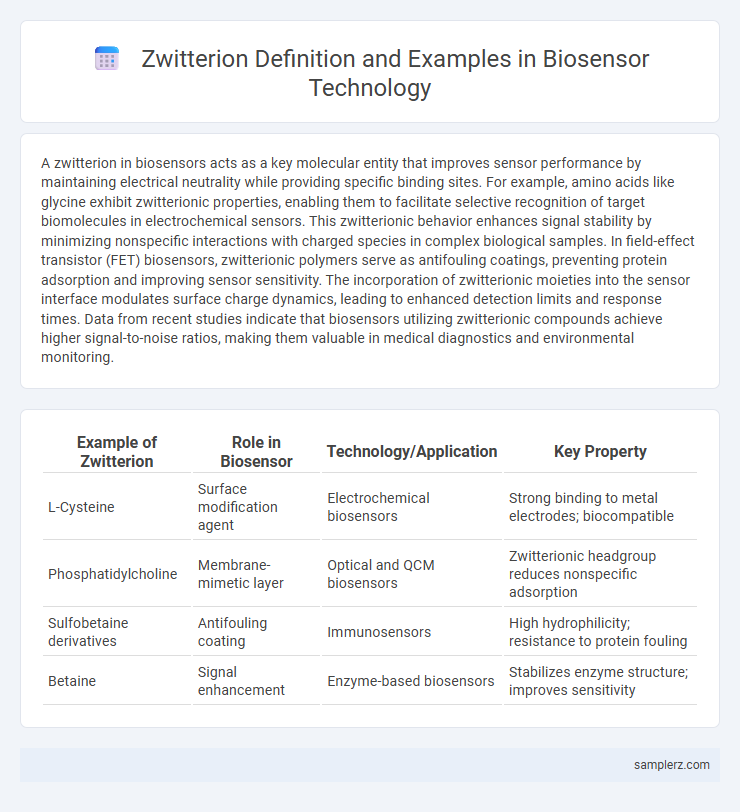A zwitterion in biosensors acts as a key molecular entity that improves sensor performance by maintaining electrical neutrality while providing specific binding sites. For example, amino acids like glycine exhibit zwitterionic properties, enabling them to facilitate selective recognition of target biomolecules in electrochemical sensors. This zwitterionic behavior enhances signal stability by minimizing nonspecific interactions with charged species in complex biological samples. In field-effect transistor (FET) biosensors, zwitterionic polymers serve as antifouling coatings, preventing protein adsorption and improving sensor sensitivity. The incorporation of zwitterionic moieties into the sensor interface modulates surface charge dynamics, leading to enhanced detection limits and response times. Data from recent studies indicate that biosensors utilizing zwitterionic compounds achieve higher signal-to-noise ratios, making them valuable in medical diagnostics and environmental monitoring.
Table of Comparison
| Example of Zwitterion | Role in Biosensor | Technology/Application | Key Property |
|---|---|---|---|
| L-Cysteine | Surface modification agent | Electrochemical biosensors | Strong binding to metal electrodes; biocompatible |
| Phosphatidylcholine | Membrane-mimetic layer | Optical and QCM biosensors | Zwitterionic headgroup reduces nonspecific adsorption |
| Sulfobetaine derivatives | Antifouling coating | Immunosensors | High hydrophilicity; resistance to protein fouling |
| Betaine | Signal enhancement | Enzyme-based biosensors | Stabilizes enzyme structure; improves sensitivity |
Understanding Zwitterions: Key Players in Biosensor Technology
Zwitterions, molecules containing both positive and negative charges, play a crucial role in biosensor technology by enhancing biocompatibility and stability of sensor surfaces. Phosphorylcholine-based zwitterionic coatings minimize nonspecific protein adsorption, improving sensor sensitivity and accuracy. Integrating zwitterionic materials in biosensors ensures robust signal transduction and long-term operational performance in complex biological environments.
Zwitterionic Materials: Enhancing Biosensor Performance
Zwitterionic materials, such as phosphorylcholine and sulfobetaine polymers, significantly enhance biosensor performance by improving antifouling properties and increasing sensitivity in complex biological environments. These materials create a hydration layer that resists nonspecific protein adsorption, thereby maintaining sensor accuracy and stability. Incorporating zwitterionic coatings in biosensors enables reliable detection of biomarkers at low concentrations, crucial for early diagnosis and real-time monitoring.
Case Study: Sulfobetaine Zwitterions in Glucose Sensors
Sulfobetaine zwitterions enhance glucose sensors by improving biocompatibility and reducing protein fouling on sensor surfaces. This zwitterionic modification increases sensor stability and accuracy in glucose detection through effective antifouling properties. Studies demonstrate sulfobetaine-functionalized electrodes provide reliable, long-term monitoring in continuous glucose monitoring systems.
Phosphorylcholine-Based Zwitterions: Anti-fouling Layers in Biosensors
Phosphorylcholine-based zwitterions serve as highly effective anti-fouling layers in biosensors, significantly reducing protein adsorption and biofouling on sensor surfaces. Their unique zwitterionic nature, featuring both positive and negative charges, creates a hydration layer that resists non-specific biomolecule attachment, thereby enhancing biosensor sensitivity and stability. These properties make phosphorylcholine derivatives ideal for improving the performance of implantable and wearable biosensing devices in clinical diagnostics.
Zwitterionic Hydrogels for High-Sensitivity Biosensors
Zwitterionic hydrogels, characterized by their unique balanced positive and negative charges, enhance biosensor performance by minimizing nonspecific protein adsorption and biofouling. These materials improve the sensitivity and selectivity of biosensors, making them ideal for detecting low concentrations of biomarkers in complex biological fluids. Their robust antifouling properties and high swelling capacity contribute to stable signal transduction and prolonged sensor lifespan in biomedical applications.
Polycarboxybetaine Zwitterions: Improving Selectivity in Biosensing
Polycarboxybetaine zwitterions enhance biosensor performance by providing superior antifouling properties, which significantly improve selectivity and sensitivity in complex biological environments. Their unique zwitterionic structure minimizes nonspecific protein adsorption, enabling more accurate detection of target biomolecules. Incorporating polycarboxybetaine coatings in biosensors has demonstrated improved stability and reproducibility, crucial for reliable biomedical diagnostics.
Zwitterion-Modified Electrodes: Reducing Nonspecific Binding
Zwitterion-modified electrodes enhance biosensor performance by reducing nonspecific binding through their balanced positive and negative charges, which create a hydration layer that resists protein adsorption. This modification improves sensor sensitivity and specificity, crucial for accurate biomolecular detection in complex biological samples. Incorporating zwitterionic polymers such as phosphorylcholine or sulfobetaine on electrode surfaces has demonstrated significant improvements in antifouling properties for electrochemical biosensors.
Emerging Trends: Zwitterionic Coatings in Wearable Biosensors
Zwitterionic coatings in wearable biosensors enhance antifouling properties by preventing nonspecific protein adsorption, thereby improving sensor accuracy and longevity. These coatings utilize balanced positive and negative charges to maintain hydration layers, which boosts biocompatibility for continuous health monitoring applications. Emerging trends highlight their integration in flexible, skin-conformal devices for real-time physiological data collection.
Zwitterion-Functionalized Nanoparticles for Targeted Biosensing
Zwitterion-functionalized nanoparticles enhance biosensor performance by providing anti-fouling properties and improved biocompatibility, enabling precise targeting of biomolecules. These nanoparticles exhibit unique charge neutrality that prevents non-specific adsorption, increasing sensitivity and stability in complex biological environments. Their application in detecting biomarkers and pathogens allows for rapid, accurate diagnostics in clinical and environmental monitoring.
Future Prospects: Expanding Biosensor Applications with Zwitterions
Zwitterions, characterized by their dual charged groups, enhance biosensor sensitivity and antifouling properties, enabling precise detection of biomolecules in complex biological fluids. Future prospects include integrating zwitterionic materials in wearable biosensors for real-time health monitoring and expanding applications towards environmental toxin detection. Advancements in zwitterion-based nanocomposites promise to improve biosensor stability and selectivity, driving innovation in medical diagnostics and personalized medicine.

example of zwitterion in biosensor Infographic
 samplerz.com
samplerz.com